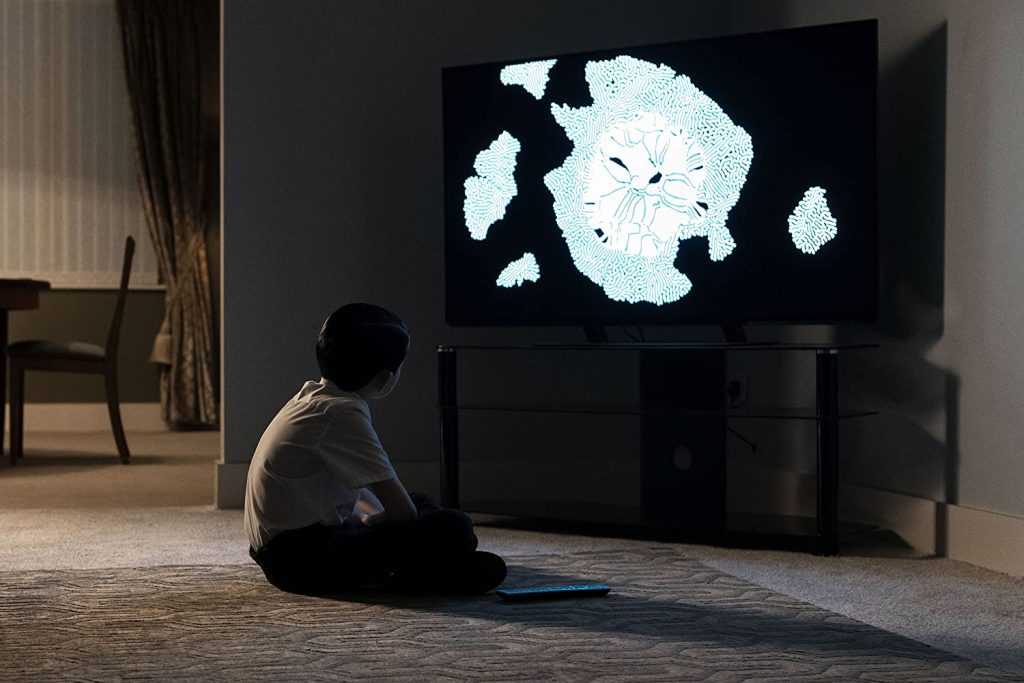March 27, 2020
by Carla Hay

Directed by Lorcan Finnegan
Culture Representation: Taking place in an unnamed city in England, the sci-fi thriller “Vivarium” has an all-white cast representing the middle-class.
Culture Clash: An unmarried couple who live together go to a mysterious housing development to look for a new home and find out that they can’t leave.
Culture Audience: “Vivarium” will appeal mostly to people who like unsettling suspense stories with a sci-fi angle.

“Vivarium” is a somewhat haunting sci-fi thriller that’s meant to give people the creeps and/or anxiety throughout the entire film. The movie—directed by Lorcan Finnegan and written by Garret Shanley—is actually a very simple story that gets drawn out over approximately 97 minutes. The middle of the film has a very sluggish pace, but there’s enough of the story to keep people interested to find out what happens in the end.
In the beginning of “Vivarium,” there are startling images of hungry baby birds in nests, demanding to be fed by their parents. It’s a metaphor for what happens later in the story, which takes place in present-day England. Gemma Pierce (played by Imogen Poots) is a teacher at a primary school (which is called elementary school in the United States) to children who look about 5 or 6 years old. After school lets out for the day, one of the girl students finds two baby birds stomped to death near a tree in the school front lawn.
It’s here that viewers first see Gemma’s live-in American boyfriend Tom (played by Jesse Eisenberg), who climbs down from a ladder placed near the tree where the birds were found. It’s not made clear what Tom does for a living, but since this is one of the movie’s few scenes that’s set in the “outside world,” one can assume he works as a handyman at the school.
Tom and Gemma are looking for a house and they have an appointment at a real-estate company that wants to show them a new housing development in the area. When they arrive at the office, Gemma and Tom are greeted by a very creepy real-estate agent named Martin (played by Jonathan Aris), who has the kind of unblinking, crazy-eyed look that would make most people feel very uncomfortable. There’s something “off” about his mannerisms too: His smile is too fake, his way of talking seems unnatural, and at one point in the conversation, he mimics what Gemma says, almost as if he’s mocking her.
Tom senses that something isn’t quite right about Martin, and so Tom is a little reluctant to go any further in the inquiry about the house. However, Gemma (in an effort to be polite) indicates that she still wants to see the property. Against his better judgment (and since they arrived in the same car), Tom agrees to go with Gemma to get a tour of the house. They follow Martin (who drives in a separate car) to see the house where they might live.
The housing development is named Yonder, which Martin describes as “both tranquil and practical.” And it’s definitely a Stepford-type environment. All of the development’s green two-story houses and yards are identical to each other. Somehow, Tom and Gemma don’t notice that there is no one outside on the streets of this large neighborhood. It’s a major red flag of what’s to come.
Unfortunately, probably because of this film’s low budget, all of the exterior shots of the housing development looks very CGI fake. Once the characters are in the mysterious Yonder environment, it’s very obvious where the “green screen” is whenever there are scenes that are supposed to take place outside.
During a brief tour of the house, which has the number 9 as its address, Martin abruptly leaves Tom and Gemma at the house without a goodbye or any explanation. Gemma and Tom are ready to just write it off as a weird experience, so they get in their car to leave. But every time they try to find their way out of Yonder, they come right back to the house where they were. The bird’s eye view of the Yonder housing development also looks very CGI fake, like a video game.
This circling around the neighborhood goes on for quite a bit, as Tom argues with Gemma, demands to do the driving, and then he gets “lost” too. Gemma and Tom soon find out that they have no cell phone service. And as it starts to get dark, the car runs out of gas. In a major plot hole, Gemma and Tom don’t even try to see if anyone else is home who can help. Not that it would matter, since the movie’s entire plot is about them being stuck in this neighborhood with no one to help them get out.
Exhausted by their strange ordeal, they have no choice but to spend the night at the house. Tom and Gemma look in the house’s refrigerator and find it has a gift basket containing a bottle of champagne and strawberries, which Gemma and Tom consume since they have nothing else to eat and drink. Tom remarks that the strawberries have no taste.
The next day, Tom has the idea that he and Gemma should follow the direction of the sun to find their way out. They spend most of the day doing just that, climbing over neighbors’ fences and trekking through the streets. But to no avail. As it gets dark, the only house that they see with its lights on is the same No. 9 house that they were at in the beginning.
Then another strange thing happens: A box of food and other house essentials have mysteriously been delivered at the front of the house. (There’s no sign of who delivered the box.) Out of desperation, Tom (who’s a smoker) decides to use one of his cigarettes to light the house on fire, to see if anyone will notice the fire and call for help. Tom and Gemma watch nearby as the house burns to the ground, before they fall asleep.
When they wake up, Gemma and Tom are covered in ash. And the house has mysteriously appeared again, completely intact, as if the fire never happened. And then they get another box delivered to them. And what’s in the box sets in motion the rest of what happens to Tom and Gemma in the story.
The box has a baby boy in it, with a message: “Raise the child and be released.” Given that Gemma and Tom are stuck in this weird limbo environment, they basically don’t have a choice but to raise the child. (Côme Thiry plays the child as a baby.) The movie then fast forwards to 98 days later, and the baby has grown into what looks like a human boy who’s about 7 or 8 years old (played by Senan Jennings), thereby making it very clear to viewers that whoever Tom and Gemma are raising is definitely not human.
Tom is extremely resentful of the child, who has a tendency to randomly scream at the top of his lungs until he gets something. He always screams this way when he wants food, which is a nod to the bird scene that was shown in the beginning of the movie. One of the creepiest aspects of “Viviarium” is that the child (who doesn’t have a name) mimics what Tom and Gemma say in their own voices. The boy has a normal child’s voice, but more often than not, the voice that comes out when he speaks is a male or female adult voice.
Tom is quick to lose his temper and, at times, he deliberately abuses the child through physical assault and later by locking him in the car and refusing to give him food. Tom also refuses to call the child “he” and instead calls the child “it.” Gemma doesn’t like taking care of the child either, but she’s more patient than Tom is. In a scene that sums up their feelings about their forced parenting of this odd creature, Tom and Gemma both show the child their middle fingers in anger, and the child does the same.
The middle section of the film somewhat drags down the pace of the story. There are repetitive scenes of the boy doing things that irritate Tom and Gemma. Although Tom wants to try and get rid of the boy in some way, Gemma can’t bring herself to do it, no matter how much she detests taking care of the boy.
At this point in the story, Tom has a distraction to keep him out of the house for long periods of time. He’s discovered, by flicking a cigarette on the front lawn, that the cigarette has burned a mysterious circle on the grass, which exposes the dirt on the ground. Tom begins digging the dirt and hears menacing sounds underneath. Digging as far as he can into the ground then becomes Tom’s obsession and takes up a great deal of his (and this movie’s) time. In one scene, Gemma speculates that the hole that Tom is digging will lead to hell. Tom replies, “No, we’re already there.”
Meanwhile, the boy who lives with them has been fixating on watching something bizarre on the house’s TV: black-and-white color patterns that look like psychedelic cell mutations. And in the house, Gemma finds a book that has strange coding and illustrations which are clues to what is possibly going on and what kind of being that she and Tom are raising.
“Vivarium” is by no means on the level of a Christopher Nolan sci-fi movie. A Nolan film has layers and layers of deep meaning that viewers will contemplate long after the movie is over. The ending of “Vivarium” actually explains exactly why all of this is happening to Tom and Gemma. The explanation is kind of basic and actually not all that surprising.
And because so much of “Vivarium” is repetitive (Tom and Gemma’s stir-crazy angst is pretty much 90% of the movie), the movie probably would’ve been better as a short film. However, if you’re looking for a movie to pass the time and give you some suspenseful chills, “Vivarium” should do the trick. Just don’t expect anything close to a masterpiece.
Lionsgate and Saban Films released “Vivarium” on digital and VOD on March 27, 2020. The film’s Blu-ray and DVD release is on May 12, 2020.
